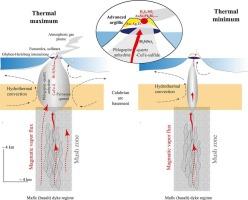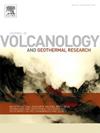The 1990's thermal crisis at La Fossa volcano (Aeolian Islands, Italy): Systematics of magmatic vapor plume expansion and decay within an active volcano
IF 2.3
3区 地球科学
Q2 GEOSCIENCES, MULTIDISCIPLINARY
Journal of Volcanology and Geothermal Research
Pub Date : 2025-09-22
DOI:10.1016/j.jvolgeores.2025.108450
引用次数: 0
Abstract
The La Fossa cone on Vulcano island (Italy), like most active volcanoes, undergoes periodic phases of increased heat and gas discharge unrelated to surface magmatism. Variations in the major component chemistry of fumaroles during such cycles record the expansion and contraction of a magmatic vapor plume beneath the volcano in response to cycles of mafic magma intrusion several km below the surface and consequent changes in its interaction with surrounding meteoric water/seawater.
Using previously unpublished major and minor element fumarole data for the 1990's thermal crisis at La Fossa in conjunction with a primary mafic magma vapor composition derived from melt inclusion data and silicate melt-vapor partition coefficients, a thermochemical equilibrium model is developed to explain variations in fumarole gas chemistry in terms of subsurface gas-solid reactions during magmatic vapor expansion and dilution from source to surface. These reactions control total S and H2 through the production of anhydrite (CaSO4) and sulfide minerals. Pyrite, bismuthinite and sphalerite deposition, control the minor element composition of fumarole discharges. Most of the Cu is deposited as CuFe sulfides in the core of the expanding vapor plume so that it is not observed at surface. As is observed in fumarole sublimates, Au is deposited at low pressure in response to removal of H2S by sulfide deposition.
The thermochemical modelling results coupled with fumarole sublimate compositional data provide a metal zonation model for the interior of La Fossa that may be considered generic for other active volcanoes and their ancient equivalents.

1990年代La Fossa火山(意大利伊奥利亚群岛)的热危机:活火山内岩浆蒸汽羽膨胀和衰变的系统
意大利火山岛上的拉福萨锥,像大多数活火山一样,经历了与表面岩浆活动无关的热量增加和气体排放的周期性阶段。在这种旋回过程中,喷气孔主要成分化学的变化记录了火山下岩浆蒸汽柱的膨胀和收缩,这是对地表以下几公里处岩浆侵入的旋回的反应,以及随之而来的与周围大气水/海水相互作用的变化。利用先前未发表的1990年代La Fossa热危机的主要元素和少量元素喷气孔数据,结合熔体包裹体数据和硅酸盐熔体-蒸汽分配系数得出的基性岩浆蒸汽组成,建立了一个热化学平衡模型,以解释喷气孔气体化学的变化,即岩浆蒸汽从源头到表面膨胀和稀释过程中的地下气固反应。这些反应通过产生硬石膏(CaSO4)和硫化物矿物来控制总S和H2。黄铁矿、铋铁矿和闪锌矿的沉积,控制着火山喷发物的微量元素组成。大部分Cu以CuFe硫化物的形式沉积在膨胀蒸汽羽流的核心,因此在表面无法观察到。正如在火山喷发孔升华物中观察到的那样,金是在低压下沉积的,这是硫化物沉积去除H2S的反应。热化学模拟结果与喷气孔升华成分数据相结合,为La Fossa内部提供了一个金属分带模型,这可能被认为是其他活火山及其古代等效火山的通用模型。
本文章由计算机程序翻译,如有差异,请以英文原文为准。
求助全文
约1分钟内获得全文
求助全文
来源期刊
CiteScore
5.90
自引率
13.80%
发文量
183
审稿时长
19.7 weeks
期刊介绍:
An international research journal with focus on volcanic and geothermal processes and their impact on the environment and society.
Submission of papers covering the following aspects of volcanology and geothermal research are encouraged:
(1) Geological aspects of volcanic systems: volcano stratigraphy, structure and tectonic influence; eruptive history; evolution of volcanic landforms; eruption style and progress; dispersal patterns of lava and ash; analysis of real-time eruption observations.
(2) Geochemical and petrological aspects of volcanic rocks: magma genesis and evolution; crystallization; volatile compositions, solubility, and degassing; volcanic petrography and textural analysis.
(3) Hydrology, geochemistry and measurement of volcanic and hydrothermal fluids: volcanic gas emissions; fumaroles and springs; crater lakes; hydrothermal mineralization.
(4) Geophysical aspects of volcanic systems: physical properties of volcanic rocks and magmas; heat flow studies; volcano seismology, geodesy and remote sensing.
(5) Computational modeling and experimental simulation of magmatic and hydrothermal processes: eruption dynamics; magma transport and storage; plume dynamics and ash dispersal; lava flow dynamics; hydrothermal fluid flow; thermodynamics of aqueous fluids and melts.
(6) Volcano hazard and risk research: hazard zonation methodology, development of forecasting tools; assessment techniques for vulnerability and impact.

 求助内容:
求助内容: 应助结果提醒方式:
应助结果提醒方式:


